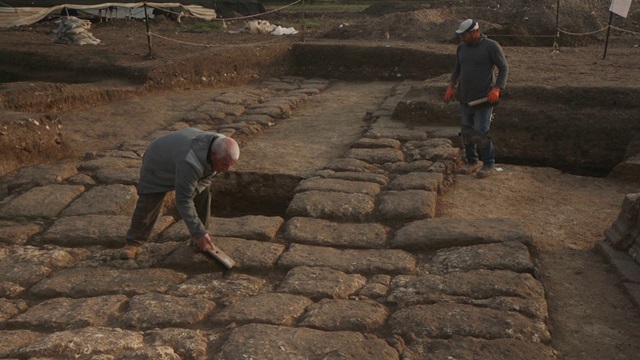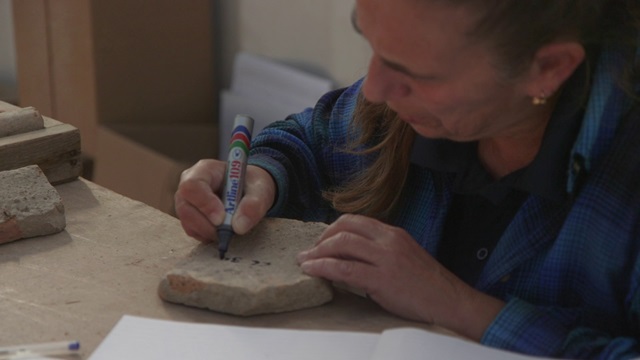Archeologists from the Israel Antiquities Authority (IAA) made yet another historic discovery. Architectural remains of the 1,800-year-old Roman VIth ‘Ferrata’ Iron Legion military base were uncovered in a recent excavation it carried out by at the foot of Tel Megiddo (near Haifa), close to the ancient Kfar Othnay village (Greek: Capercotnai).
The IAA said that in the course of the excavation, “extensive and impressive architectural remains” of the Via Pretoria (the main road of the camp) were uncovered, as well as a semicircular-shaped podium and stone-paved areas which were part of a large, monumental public building. The VIth Legion Roman legionary base is the only Roman military base of these dimensions that has been located and exposed in the Land of Israel.
The news comes just a few weeks after an everyday person in Israel, a hiker, discovered an ancient and rare Assyrian amulet in Israel’s Nahal Tabor Nature Reserve in the Lower Galilee. And in January Israeli archeologists uncovered an extremely rare 2,500 year old silver coin was found in the Judean Hills.
Will you offer us a hand? Every gift, regardless of size, fuels our future.
Your critical contribution enables us to maintain our independence from shareholders or wealthy owners, allowing us to keep up reporting without bias. It means we can continue to make Jewish Business News available to everyone.
You can support us for as little as $1 via PayPal at office@jewishbusinessnews.com.
Thank you.
Also in January, Israeli reserve soldiers discovered a large ancient vessel made of basalt – a mortar – which was used to grind grain which they found in a wrapping in a military assembly area near Gaza.
“The Roman Legion camp at Legio was the permanent military base for over 5,000 Roman soldiers for more than 180 years, from 117–120 to about 300 CE,” says Dr. Yotam Tepper, excavation director on behalf of the Israel Antiquities Authority.

The excavation of the Israel Antiquities Authority at Megiddo (Emil Aladjem, Israel Antiquities Authority)
Two main roads intersected at the center of the 550 m long and 350 m wide camp, and its headquarters were erected here. It was from this base point, explained Dr. Tepper, that all the distances along the Roman Imperial roads to the main cities in the north of the country were measured and marked with milestones. The ancient building remains were not preserved to a height, as most of the building stones were removed over the years for reuse in building projects carried out during the Byzantine and Early Islamic periods.
This is something scene all over the world. Old Roman and Greek buildings, for example, may seem to have fallen apart or been destroyed – like the Coliseum in Rome – but, what really happened was over the years stones were taken from them to build new buildings.
Dr. Tepper emphasized that the discovery of the legionary base was not accidental, as over the last decade, surveys and six seasons of archaeological excavations have been carried out within a joint academic geographical-historical research project directed by Dr Tepper and Dr. Matthew J. Adams, as part of the Jezreel Valley Research Project (JVRP), carried out on behalf of the Albright Institute of Archaeology in Jerusalem.
“In the course of the excavation seasons, the upper part of the commanders’ courtyard (principia) was exposed southwest of Road No. 66, and in the present excavation, carried out on behalf of the Israel Antiquities Authority, we are uncovering the northeastern part of the camp that extends alongside Road No. 66,” he said.
Preliminary surveys of the camp area, carried out in the context of the JVRP using Ground-Penetrating Radar equipment, indicated that the entire Roman base and all its components underlie the wheat fields of Kibbutz Megiddo. “The unique contribution of the results of this research project lies in the rarity of such archaeological discoveries,” says Tepper. Whilst Roman military camps are known in Israel, they are temporary siege camps, or small camps belonging to auxiliary divisions. None compares with the entire complex of the legionary base, as has been uncovered in the archaeological excavations at Legio, next to the Megiddo Junction.”
Historical sources and some partial information point to the existence of a permanent Roman legionary base of the Xth Fratensis Legion in Jerusalem, but the camp remains to be discovered.”
In the excavation, coins, parts of weapons, pottery sherds and glass fragments were uncovered, but the most predominant finds are the rooftiles that have been found in extremely large quantities. “The rooftiles, some of which were stamped with the VIth Legion stamps, were used for various purposes, for roofing buildings, paving floors and coating walls. The technology and know-how, the building techniques, and the weapons that the Legion brought with it from the home country, are unique to the Roman army, reflecting specific Roman Imperial military footprints.”




